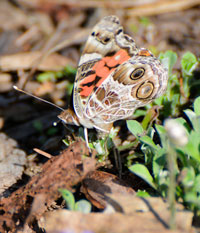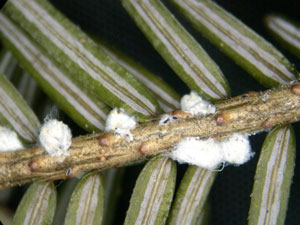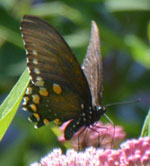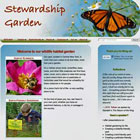 |
American Lady laying an egg on pussytoes ( Antennaria) (click on image to learn more about American Lady butterflies)
|
Summer is the time for the traditional Wild Ones "Show Me, Help Me" tours. The "Show Me" part means that these landscapes will show tour guests some ways to use native plants and natural landscapes in various settings. The "Help Me" part means that the host has an opportunity to ask the tour guests for help with a landscaping dilemma, getting a chance to tap into the variety of experiences and knowledge the guests have. Our tours each have a unique mix of "Show Me" and "Help Me," but they're all interesting and worthwhile. As with our meetings, the Show Me, Help Me tours are free and open to the public. Upcoming tours
Sat. July 12 at 10 am
Show Me after Help Me Tour
Last year, we enjoyed a Show Me Help Me tour of Soule Leiter's landscape. There was a lot of "Show Me" since Soule has been working on her landscape for a number of years, but there was some "Help Me," too, as Soule asked for some suggestions for various spots. She took action on the tour guests' suggestions and has invited us back to see the results! RSVP to Soule and she'll send directions. My yardI'll be giving some more tours of my yard, too, on the dates listed below. I'll send directions upon receiving your RSVP by email. Please indicate which tour date you will be attending Each tour is limited to 8 people, but "re-visitors" are welcome! Tues. July 15 at 6:00 pm Sat. July 19 at 9:00 am Sun. July 27 at 4:00 pm Sat. Aug 2 at 9:00 am We hope you can attend at least one tour to see habitat gardening with native plants in action! Janet Allen, President, HGCNY
|
 |
|
You can help create "Hometown Habitat"
|
We generally have "live" programs, but we made two exceptions this past program year: we heard a video presentation by Doug Tallamy, and we viewed Catherine Zimmerman's Meadowscaping video. Both were enthusiastically received! Good news!Now Catherine Zimmerman is working on a new film, and it's featuring Doug Tallamy. Hometown Habitat is a 90-minute documentary that will show how and why native plants are critical to the survival and vitality of local ecosystems. Doug Tallamy will provide the narrative thread throughout the movie. The message: "We can change the notion that humans are here and nature is some place else. It doesn't have to, and shouldn't be that way." Each individual has the power to conserve resources, restore habitat for wildlife and bring beauty to their patch of earth. You can contributeIt costs $1500 for each minute of production, so contributions will be appreciated. You can view a trailer of the movie and make a donation on the Meadow Project website.
|
 |
|
Which plants are most productive?
|
 | | Red oak (Quercus rubra) |
In The Living Landscape (p. 104), Darke and Tallamy say, "(W)e can say with certainty that, on average, ecosystems built from indigenous plants are more species-rich than ecosystems infused with non-natives.
But can we say that all native plants are equal contributors to local animal diversity? No we cannot...
There is extraordinary variation in the degree to which different genera of indigenous plants support local food webs and thus local biodiversity."
They give as an example the contrast between native oaks (Quercus), which host 557 species of caterpillars, and the native yellowwood (Cladastris kentukia), which supports no caterpillars. Which would be most missed if they disappeared?
To provide the most benefits, try to plant some of the most ecologically productive plants in your own yard. Which are those? Wild Ones has published a handy guide based on Tallamy's research that illustrates the differences between plants. For example, some of the most productive native plants in terms of their ability to support caterpillars are
Oaks (Quercus) - 557 lepidoptera
Cherries (Prunus) - 456
Willows (Salix) - 455 (Note: Weeping willow is not native)
Birches (Betula) - 411
whereas
Spicebush (Lindera) only supports 11.
This is not to say that plants such as spicebush don't belong in our landscapes (and the spicebush swallowtail butterfly certainly would agree!), but that it's important to include many of the most productive plants.
Our native/invasive plant handout lists some of these Biodiversity All-Stars.
|
 |
 | | Hemlock wooly adelgid
Photo: ME Dept. of Agriculture
|
The New York Times article " After the Trees Disappear" gives a picture of what our forests might be like when the ash trees disappear. (Some experts believe that we may lose 99% of our ashes; others believe certain species of ashes will be more dramatically affected than others.) One study found that 43 native insect species rely on ashes for food or breeding -- and that those insects are important sources of food for birds, such as woodpeckers.
And the gaps left by the dead trees may be filled by invasive honeysuckle bushes.
Hemlock wooly adelgid in Skaneateles watershed As the above New York Times article points out, although the hemlock wooly adelgid (HWA) is not as fast or deadly as the ash borer, the consequences can be just as severe because hemlocks often grow in groves of nothing but hemlocks. The character of the forest could shift from dark, cool and moist to sunnier, warmer and drier, leading to a series of other ecological effects. For Syracuse, whose water is supplied by Skaneateles, the loss of hemlocks could mean more runoff into what is currently a crystal-clear lake. Read more in the Syracuse Post-Standard article.Read more on the NYS DEC's webpage on the wooly adelgid, including links to how to identify and report the HWA, a map and more.
|
 |
|
2014 Native Plant Shopping Guide
|
 Our 2014 Guide has the same general format as our previous Guides with a few new codes: Our 2014 Guide has the same general format as our previous Guides with a few new codes:
- F indicates Pesticide-Free plants - BB indicate plants especially good for bumble bees. Both qualities are important. Click on the photo above or HERE to download the entire Guide as one .pdf file. OR you can download any or all of the parts separately for printing. Here are the THREE PARTS of this guide: If your computer downloads the files, but you don't know where they are, look in your browser settings to find your Downloads folder. Still having trouble? Contact us and we'll email the .pdf file to you directly. The Introduction section Whether or not you print it out, please read the Introduction for Shopping Tips, contact information for the vendors and other helpful information. We recommend that you CALL AHEAD before you set out on your shopping trip! Confirm the hours the nurseries are open and confirm that your selected plants are currently in stock. What is available in May, for example, may not be available in July. Call ahead to avoid disappointments and wasted gas! Thank you for patronizing our local native plant nurseries. Supporting these nurseries is an important way to grow the native plant movement. |
|
|
|
Help revitalize Onondaga Lake's shoreline
|
Join the Onondaga Lake Conservation Corps team of volunteers to transform the lake's western shoreline into unique wetlands and lakeshore habitat. When: Sat. July 19, 9 am - noon Where: Onondaga Lake Visitors Center RSVP to
|
|
Butterflies and Skippers of Onondaga County
|
 | | Pipevine swallowtail nectaring on swamp milkweed |
Have you ever wondered what butterflies you're most likely to see right here in Onondaga County? BAMONA (Butterflies and Moths of North America) has checklists for each county on their website. Based on their list, I also compiled a one-page list of these butterflies and skippers, and it's available as a handout on our website. HOWEVER, I was surprised to see this pipevine swallowtail butterfly-not on the list- appear in our yard. (And we do have a pipevine!) The ID was confirmed by BugGuide.net.
|
|
Start planning for our HGCNY fall plant sale
|
 | | Sedum ternatum |
It's not too early to starting thinking about our fall plant sale.
Here are two ways you can help:
1) Think about which plants you would like to purchase at our sale. We'll try to have them available if we find a source. Email John with your requests. 2) As you observe your plantings this spring and summer, note which plants you'd like to donate to our sale. Consider potting them up early so they're established in their pots in time for our sale on Sept. 13. Our plant sale profits fund this newsletter and other HGCNY activities.
|
Since HGCNY is a chapter of the national organization Wild Ones, when you become a member of Wild Ones, you're automatically a member of HGCNY, too. And since Wild Ones is an official not-for-profit, your membership is tax-deductible.
It's easy to become a member, receive the bimonthly Wild Ones Journal, and support our mission.
|
As more of us participate on our Facebook page at www.facebook.com/hgcny, this will become a useful resource for asking (and answering!) local HGCNYers' questions about habitat gardening.
|
|
Our Habitat Garden website
|
 Visit Our Habitat Garden website for information on providing habitat, earth-friendly gardening practices, plants, and various creatures here in Central New York. |
Visit Our Edible Garden website to see an example of a local vegetable and fruit garden. An edible garden is a perfect complement to your habitat garden.
|
|
 |
|